Related Research Articles

The M109 is an American 155 mm turreted self-propelled howitzer, first introduced in the early 1960s to replace the M44. It has been upgraded a number of times, most recently to the M109A7. The M109 family is the most common Western indirect-fire support weapon of maneuver brigades of armored and mechanized infantry divisions.

The AS-90, known officially as Gun Equipment 155 mm L131, is an armoured self-propelled artillery weapon used by the British Army.
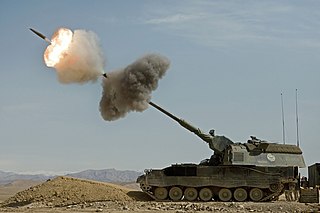
The Panzerhaubitze 2000, abbreviated PzH 2000, is a German 155 mm self-propelled howitzer developed by Krauss-Maffei Wegmann (KMW) and Rheinmetall for the German Army. The PzH 2000 is one of the most powerful conventional artillery systems deployed in the 2010s. It is capable of a very high rate of fire; in burst mode it can fire three rounds in nine seconds, ten rounds in 56 seconds, and can—depending on barrel heating—fire between 10 and 13 rounds per minute continuously. The PzH 2000 has automatic support for up to 5 rounds of Multiple Rounds Simultaneous Impact (MRSI). The replenishment of shells is automated. Two operators can load 60 shells and propelling charges in less than 12 minutes. PzH 2000 has also been selected by the armies of Italy, Netherlands, Greece, Lithuania, Hungary, Qatar and Croatia, mostly replacing older systems like the M109 howitzers.

Modern French 100 mm naval guns are multipurpose artillery pieces, capable of a high rate of fire. Most modern French warships are/were equipped with one of its versions.

An autoloader or auto-loader is a mechanical aid or replacement for the personnel that load ordnance into crew-served weapons without being an integrated part of the gun itself. The term is generally only applied to larger weapons, such as naval weapons, tanks and artillery, that would otherwise have a dedicated person or persons loading them.

The OTO Melara 76 mm gun is a naval gun built and designed by the Italian defence company Oto Melara. It is based on the Oto Melara 76/62C and evolved toward 76/62 SR and 76/62 Strales.
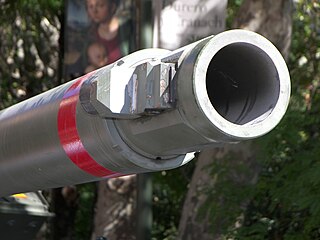
The Rheinmetall Rh-120 is a 120 mm smoothbore tank gun designed and produced by the West German Rheinmetall-DeTec AG company, developed in response to Soviet advances in armor technology and development of new armored threats. Production began in 1974, with the first version of the gun, known as the L/44 as it was 44 calibers long, used on the German Leopard 2 tank and soon produced under license for the American M1A1 Abrams and other tanks. The 120-millimeter (4.7 in) gun has a length of 5.28 meters (17.3 ft), and the gun system weighs approximately 3,317 kilograms (7,313 lb).
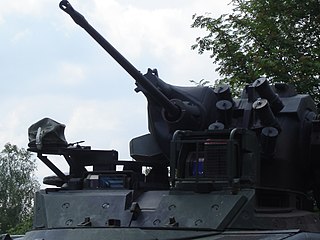
The Rheinmetall Mk 20 RH-202 is a 20 mm caliber autocannon designed and produced by Rheinmetall. It fires the 20×139mm ammunition originally developed for the Hispano-Suiza HS.820.

The Advanced Gun System (AGS) is a naval artillery system developed and produced by BAE Systems Armaments Systems for the Zumwalt-class destroyer of the United States Navy. Designated the 155 mm/62 (6.1") Mark 51 Advanced Gun System (AGS), it was designed to provide long range naval gunfire support against shore-based targets. A total of six of the systems have been installed, two on each of the three Zumwalt-class ships. The Navy has no plans for additional Zumwalt-class ships, and no plans to deploy AGS on any other ship. AGS can only use ammunition designed specifically for the system. Only one ammunition type was designed, and the Navy halted its procurement in November 2016 due to cost, so the AGS has no ammunition and cannot be used.

The Centauro is a family of Italian military vehicles originating from a wheeled tank destroyer for light to medium territorial defense and tactical reconnaissance. It was developed by a consortium of manufacturers, the Società Consortile Iveco Fiat - OTO Melara (CIO). Iveco Fiat was tasked with developing the hull and propulsion systems while Oto Melara was responsible for developing the turrets and weapon systems.

The 3.7 cm Flak 18/36/37 was a series of anti-aircraft guns produced by Nazi Germany that saw widespread service in the Second World War. The cannon was fully automatic and effective against aircraft flying at altitudes up to 4,200 m. The cannon was produced in both towed and self-propelled versions. Having a flexible doctrine, the Germans used their anti-aircraft pieces in ground support roles as well; 37 mm caliber guns were no exception to that. With Germany's defeat, production ceased and, overall, 37 mm caliber anti-aircraft cannon fell into gradual disuse, being replaced by the Bofors 40 mm gun and later, by 35-mm anti-aircraft pieces produced in Switzerland.
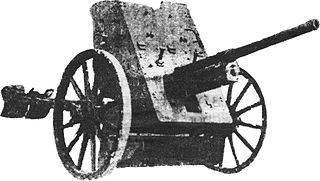
37 mm anti-tank gun model 1930 (1-K) was a Soviet light anti-tank gun used in the first stage of the German-Soviet War.
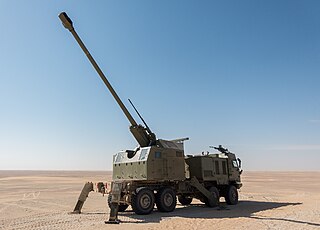
The Nora B-52 is a 155 mm self-propelled howitzer weapon system developed by Military Technical Institute Belgrade for export and domestic use. The first self-propelled Nora B was designed by MTI in 1984 with a modified 152 mm gun-howitzer M84 NORA mounted on an FAP 8x8 truck bed and was a third generation of artillery weapons.
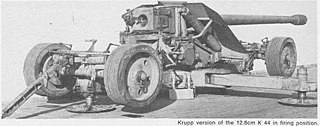
The 12.8 cm Pak 44 was a German anti-tank gun used during World War II. It was designed as a result of experiences on the Eastern front in 1943. The German Army came upon the Soviet 122 mm field guns and issued a requirement for a similar weapon. Development initially concentrated on a field gun known as the Kanone K 44. However, once heavier Soviet tanks such as the IS-2 started to appear, the design requirements were altered to include an anti-armour role.

The PLZ-45 or Type 88 is a 155 mm self-propelled howitzer designed by Su Zhezi of 674 Factory, and developed by Norinco, 123 Factory, 127 Factory, 674 Factory and Beijing Institute of Technology in the early 1990s for the export market. It is based on Norinco's Type 89 (PLL01) 155mm/45-calibre towed gun-howitzer.

The Oto Melara 127/64 Lightweight (LW) naval gun mount is a rapid-fire gun mount suitable for installation on large and medium size ships. It also has a version for coastal defense, intended for surface fire and naval gunfire support as main role and anti-aircraft fire as secondary role. The compactness of the gun feeding system makes possible the installation on narrow section crafts.
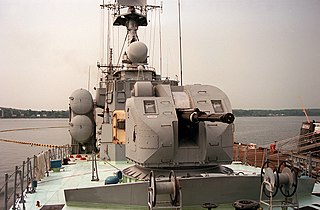
The AK-176 is a Soviet naval gun mounted in an enclosed turret, that may be used against sea, coastal, and aerial targets, including low flying anti-ship missiles. The system is designed to arm small displacement ships and comprises the Gun Mount with a MR-123-02/76 Fire Control Radar System. It has high survivability owing to autonomous use of the gun mount controlled from the optical sight in the absence of control from the radar system, as well as a capability for fire even if power supply is lost.

The Artillery Gun Module is an air-portable self-propelled howitzer designed by Krauss-Maffei Wegmann. It is based on technology used in the German Army Panzerhaubitze 2000 system, to provide more air portable self-propelled artillery, transportable by Airbus A400 aircraft.

The Denel 35mm Dual Purpose Gun (35DPG) is a close-in weapon system (CIWS) for warships built in South Africa by Denel Land Systems. It is currently in service on the Valour-class frigates of the South African Navy.
Cannon-launched guided projectiles are precision-guided munitions launched by howitzers, mortars, tank guns, and naval guns. Cannon Launched Guided Projectiles commonly referred to by the abbreviation CLGP are intended to supplement and not supplant conventional rounds, providing additional accuracy when needed. For example, the INVAR missile system on the T-90 MBT.
References
- ↑ https://web.archive.org/web/20051112194002/http://www.rheinmetall-detec.de/index.php?lang=3&fid=742 Rheinmetall Defence press release page about MONARC
- ↑ https://geopolitiki.com/monarc-pzh-2000-turret-german-frigate MONARC | Mounting a Pzh 2000 turret to a German Frigate
- ↑ http://www.navweaps.com/Weapons/WNGER_61-52_MONARC.php German 155mm/52 MONARC